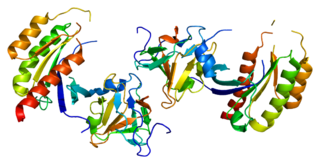GTPases are a large family of hydrolase enzymes that bind to the nucleotide guanosine triphosphate (GTP) and hydrolyze it to guanosine diphosphate (GDP). The GTP binding and hydrolysis takes place in the highly conserved P-loop "G domain", a protein domain common to many GTPases.
Small GTPases, also known as small G-proteins, are a family of hydrolase enzymes that can bind and hydrolyze guanosine triphosphate (GTP). They are a type of G-protein found in the cytosol that are homologous to the alpha subunit of heterotrimeric G-proteins, but unlike the alpha subunit of G proteins, a small GTPase can function independently as a hydrolase enzyme to bind to and hydrolyze a guanosine triphosphate (GTP) to form guanosine diphosphate (GDP). The best-known members are the Ras GTPases and hence they are sometimes called Ras subfamily GTPases.

Guanine nucleotide exchange factors (GEFs) are proteins or protein domains that activate monomeric GTPases by stimulating the release of guanosine diphosphate (GDP) to allow binding of guanosine triphosphate (GTP). A variety of unrelated structural domains have been shown to exhibit guanine nucleotide exchange activity. Some GEFs can activate multiple GTPases while others are specific to a single GTPase.

Ras-related protein Rab-8A is a protein that in humans is encoded by the RAB8A gene.

ADP-ribosylation factor GTPase-activating protein 1 is an enzyme that in humans is encoded by the ARFGAP1 gene. Two transcript variants encoding different isoforms have been found for this gene.

RhoG is a small monomeric GTP-binding protein, and is an important component of many intracellular signalling pathways. It is a member of the Rac subfamily of the Rho family of small G proteins and is encoded by the gene RHOG.

Ras-related protein Rab-1B is a protein that in humans is encoded by the RAB1B gene.

AS160, which was originally known as TBC1 domain family member 4 (TBC1D4), is a Rab GTPase-activating protein that in humans is encoded by the TBC1D4 gene.

Rho GTPase-activating protein 32 is a protein that in humans is encoded by the RICS gene. RICS has two known isoforms, RICS that are expressed primarily at neurite growth cones, and at the post synaptic membranes, and PX-RICS which is more widely expressed in the endoplasmic reticulum, Golgi apparatus and endosomes. The only known domain of the RICS is the RhoGAP domain, whilst PX-RICS has an additional Phox homology and SH3 domain.

TBC1 domain family member 1 is a protein that in humans is encoded by the TBC1D1 gene.

TBC1 domain family member 3E/3F is a protein that in humans is encoded by the TBC1D3F gene.

Ras-related protein Rab-40A is a protein that in humans is encoded by the RAB40A gene.

GTPase activating protein and VPS9 domains 1, also known as GAPVD1, Gapex-5 and RME-6 is a protein which in humans is encoded by the GAPVD1 gene.
ELMO is a family of related proteins involved in intracellular signalling networks. These proteins have no intrinsic catalytic activity and instead function as adaptors which can regulate the activity of other proteins through their ability to mediate protein-protein interactions.
GTPase-activator protein for Ras-like GTPase is a family of evolutionarily related proteins. Ras proteins are membrane-associated molecular switches that bind GTP and GDP and slowly hydrolyze GTP to GDP. This intrinsic GTPase activity of ras is stimulated by a family of proteins collectively known as 'GAP' or GTPase-activating proteins. As it is the GTP bound form of ras which is active, these proteins are said to be down-regulators of ras.

Small G protein signaling modulator 2 is a protein that in humans is encoded by the SGSM2 gene.

RAB GTPase activating protein 1 is a protein in humans that is encoded by the RABGAP1 gene.

Pleckstrin homology domain containing, family G member 5 (PLEKHG5) is a protein that in humans is encoded by the PLEKHG5 gene. Eight transcript variants encoding different isoforms have been found for this gene.

TBC1 domain family, member 24 is a protein that in humans is encoded by the TBC1D24 gene.

EVI5L is a protein that in humans is encoded by the EVI5L gene. EVI5L is a member of the Ras superfamily of monomeric guanine nucleotide-binding (G) proteins, and functions as a GTPase-activating protein (GAP) with a broad specificity. Measurement of in vitro Rab-GAP activity has shown that EVI5L has significant Rab2A- and Rab10-GAP activity.













